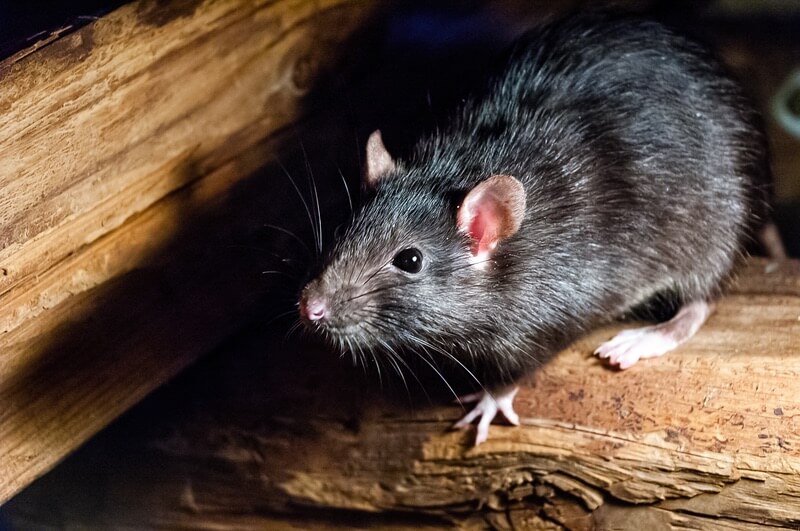Figuring out how to get rid of rats in the attic can be surprisingly tricky. These pests are resourceful and persistent, so you need to have the right approach if you want to expect success.
This guide will teach you how to get rats out of your attic, and keep them out for good.
Table of Contents
Signs That You Have Rats In Your Attic
If you’re a homeowner, then you may have already dealt with mice or squirrels in your attic. While these critters are unpleasant to have roaming around your attic or crawlspace, they are nothing compared to rats. Many people think of rats as being a problem in or near cities, but any home can be in danger of rats in the attic.
How will you be able to tell if you are dealing with rats in your attic? There are a few signs that are often diagnostic, so let’s take a look at some of the ways that you can tell if rats (namely roof rats) have invaded this space.
One of the reasons that it’s often hard to notice that you may be dealing with a rat infestation in your attic is the fact that they are nocturnal. Rats are the most active while you are sleeping, so you may not even be aware that there’s anything going on in your attic.
- Reduce the risk of rodent-linked disease as well as damage to your space with these covered rat traps
- Dual-entry tunnel rat trap is simple to use with its hands-free design
- Designed with a responsive lock chamber and a sensitive trigger pad
- Made with washable material that permits multiple uses
Noise
Suspicious noises will probably be the first sign that you have rats in your attic that you need to get rid of. Maybe you’re reading in bed and hear some scratching overhead, or perhaps you hear something running around in your attic on your way to grab a midnight snack. You may even hear chewing or scratching noises in your walls. These are all signs that rats may have invaded this area of your home.
Droppings & Damage
Another way to tell if you could be dealing with rats is if you find physical signs such as droppings, chewed up paper or clothing, or if you find gnaw marks on wood or walls. Further investigation may show chew marks on your roof or eaves, chewed up electrical wiring or claw marks on the side of your house.
Expert Tip: If the infestation is a bad one, you may even be able to smell rat urine. Don’t forget to check your attic’s insulation for signs of rat tunnels or nests.
Your Pets Know First
Animals have excellent hearing and a wonderful sense of smell. If you notice that your pets are getting anxious, are staring at the ceiling or walls or are showing obvious signs of stress, then it could be that they have already detected the rats in your attic.
Seeing Them In Action
One sure fire reason to suspect rats is if you actually see them in your neighborhood or yard. You might see them in your neighborhood running along electrical wires, climbing trees, running on your roof or scurrying across your yard.
For a definitive diagnosis it’s usually best to get in touch with a pest control specialist right away. They have the experience and knowledge to determine the size and scope of the infestation.
Why You Need To Get Them Out ASAP
Once you hear scurrying in your attic, or if you see other signs of rats, then you absolutely must get rid of them as soon as possible. This is not something that you can ignore in the hope that the problem will go away. There are some very serious health and structural issues that can occur once rats have settled in your attic.
In every way that you could possibly think of, having rats in your home is a very bad thing. Rats are linked to a number of very serious diseases that are transmitted through their feces, their urine and their bite. We’re talking about diseases like rat-bite fever, Hantavirus, plague and tularemia. Grossed out? You should be because having rats in your attic puts you at risk for getting these diseases and other severe health issues.

Rats are also known to cause huge structural damage to homes if left unchecked. They chew on wood, electrical wiring, they’ll chew holes in your roof, and they can damage walls and other structures. Rats will burrow into your attic’s insulation, they will invade your kitchen given a chance, and they will even damage water pipes.
- Reduce the risk of rodent-linked disease as well as damage to your space with these covered rat traps
- Dual-entry tunnel rat trap is simple to use with its hands-free design
- Designed with a responsive lock chamber and a sensitive trigger pad
- Made with washable material that permits multiple uses
Even just a few rats in your attic can lead to a huge problem. A pair of mating rats will very quickly become a colony you need to remove. In a single year, one female rat can have up to 80 pups. Once those pups begin to start their own families, you will have a problem that will soon be out of control.
If the case is serious, getting rid of rats in the attic might need to be dealt with by a professional. You don’t want to chance being bitten, and breathing in dried feces and urine will cause a laundry list of serious health problems.
How To Get Rid Of Rats In The Attic
Once you know that you have a rat problem in your attic, you’ll need to decide how to get rid of them. There are lots of methods out there that range from do-it-yourself treatments to hiring a professional pest control specialist.
From the traditional piece of cheese in a trap to the latest technology, there is a way to get them out or kill them that will fit your needs and your budget.
Place Traps
When you realize that you have a problem, your first instinct will probably be to set traps. While placing traps is certainly a common and sometimes effective way to get rid of rats in your attic, it’s good to have a working knowledge of the various types of traps as well as their pros and cons.
Snap Traps
There are so many kinds of traps on the market, and it is hard to know which one to choose. The one that most people are familiar with is the snap trap. This is the trap that you see in cartoons with a piece of cheese as bait. Cheese will often work in this type of trap, but there are better kinds of bait such as peanut butter, dried fruit, nesting material and berries.
A snap trap is pretty much what it sounds like. There is a metal bar that is triggered by the rat eating the bait. Once the rats in your attic start to nibble the bait, the metal bar will come down and kill the rat. That’s the theory anyway.
Snap traps are good because you can reuse them, they are fairly inexpensive, there is no poison involved, and you will know that the rat is dead. However, using a snap trap means that you will be the one to get rid of the dead rat, you may need multiple traps to get rid of all the rats in your attic, and snap traps are very dangerous around children and pets.
Glue Traps
Another common kind of trap is called a glue trap. Many people like to use these traps because they are inexpensive, easy to use, and no poison is involved. Instead of a metal bar to trap the rat, glue traps use sticky glue pads. However, before deciding to use a glue trap you’ll need to think about whether or not you will want to dispose of the trap with a potentially live rat attached. Unless you leave the rat in the glue for a long time, the rat is going to be alive when you find it.
Electronic Traps
If you’re looking to get rats out of your attic with a trap that’s non-toxic and fairly humane, then an electronic trap may be a good option. These traps use a high-voltage electric shock to do the trick. Some positive points about using electronic traps are that you’ll see a blinking light once a rat has been killed, they are easy to empty, they are reusable, and the dead rat stays hidden until you empty the trap.
Expert Tip: Electronic traps are considered safe around kids and pets, but we still recommend placing them in safe and concealed places.
Live Traps
Live traps are another option, but many homeowners don’t bother with these traps. While live traps may appear to be more humane, you will have to decide how to handle the rat that is running around inside of the cage. If you want to set the rat free somewhere away from your home, be aware that relocated rats rarely survive.
Try Ultrasonic Repellent
A fairly new method that is being used to get rats out of attics is ultrasonic repellent. This device works by sending out high-frequency sound waves that are said to drive rats and other rodents crazy. Instead of killing the rats, these sound waves are supposed to keep them from even entering your attic.
On the plus side, an ultrasonic repellent doesn’t use poison, is easy to use, plugs in anywhere and is safe to use around dogs and cats. However, you will need to use caution around guinea pigs and hamsters.
The one negative point is that, despite all of the hype about ultrasonic repellents, they don’t always work. In fact, the Federal Trade Commission has expressed doubts as to the effectiveness of these devices.
There are lots of different kinds, and there are many cheap versions that are not worth the money. We suggest doing your research before buying an ultrasonic repellent. Check with your pest control specialist if you have questions.
How To Keep Them Out In The Future
In the long run, trapping or killing a few rats is not going to cut it. You will need to take strategic and aggressive measures to ensure that the rats in your attic stay away for good.
As always, the best way to deal with a rat issue is to call in a pest control professional. However, there are things that you can do to enhance and supplement what is being done by the experts.
Block All Entry Points
The first thing that you are going to need to do is to block up any places where rats could be entering your attic. We know that this is going to be time consuming and tedious, but it is very important that you don’t leave this step out. Let’s put it this way. Rats can get into holes the size of a quarter, so if you don’t do a careful inspection of your property and then block up the entry points, then you might as well hang up a vacancy sign.
You are going to want to check areas like windows, cracks in the wall and holes near the roof and garage doors. Once you determine where the rats are entering your home, it’s time to seal up those holes.
Steel wool or caulk can be used in small holes, but larger holes need to be covered with something like hardware cloth, copper mesh, fitted foam or a screen. Attic and roof vents should be covered with a screen as should chimney openings.
If all of this seems beyond your capabilities, then there are animal control companies that may be able to help.
Trim Trees & Vines
Roof rats are very good climbers and often use tree branches and climbing ivy to reach your attic. To keep rats out of your attic, it’s going to be important to trim back branches that hang near your house, to clear away any ivy or other vines, to trim hedges and shrubbery and to generally maintain a yard that’s free of places for rats to climb.
Get Rid Of Debris
If you’ve been putting off really cleaning up your yard, then it’s time to bite the bullet and get it done. Piles of wood or branches, or any kind of rotting wood can be an absolute rat magnet. Getting rid of yard clutter will give rats less places to hide.
Cover Your Trash
A messy garbage area or half closed trash cans could be what’s attracting rats to your yard (where they can eventually find their way into your attic). Even if you have your garbage can tightly closed at all times, rats may still be able to open the lid. The best thing to do is to either bungee cord the lid down or place something heavy on top. Always make sure that the area around your trash cans is clean.
How Do Rats Get Into Your Attic?
Homeowners who discover that they have rats in their attic are often baffled as to how the rats got in there. As we mentioned earlier, rats can get into very small holes (due to their build and bone structure), especially if they find the food, water and shelter that they are looking for. Have a small crack on the side of your house or some rotten wood on the eaves? Rats will see these as the perfect way to get into your attic.
Rats will slither under garage doors, climb trees, jump from roof to roof and basically find any tiny entry point. If you see a hole and think that it’s too small for a rat, then you may get an unpleasant surprise.
How Do Exterminators Get Rid Of Rats In Attics?
You can certainly try to use do-it-yourself techniques to get rid of rats in your attic, but we don’t recommend it for serious infestations. There are many factors involved with dealing with a rat infestation, and the average homeowner is not equipped to deal with it all. The best thing to do is to call an exterminator. An exterminator will have access to various methods that you won’t.
Most of the time, an exterminator will use some kind of trap to get rid of rats in the attic. While you may be limited as to the kind of trap you can use, a pest control specialist will use only the best, most effective kind. In many cases, exit points will be left open, so that rats can clear out on their own.
After the exterminator is sure that all the rats are out of the attic, they will seal up any entry points that they find. This will help to ensure that rats won’t be able to re enter your home. Also, a good pest control company will remove rat nests, decontaminate the attic, and many companies will spray an insecticide to kill any fleas that were on the rats.
Some companies offer small rat trap boxes that are strategically placed around the perimeter of the home. Once a month, poison is placed inside, and the trap is checked for dead rats. This is a fairly safe method because the box is locked, and the opening is too small for pets to get into.
Conclusion
Now that you know how to get rid of rats in the attic, it’s time to start taking the proper steps. If you have an existing infestation that’s manageable, start by placing some traps and going from there. If you have a massive group of rats that is too much to deal with on your own, consider hiring a professional.
As always, if you have any questions about the information above you can send them our way. We’ll try to help you out as soon as we can!



